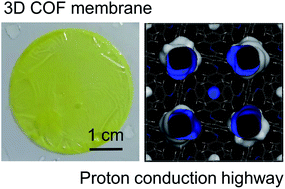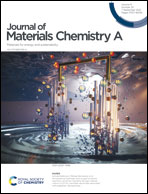Three-dimensional covalent organic framework membrane for efficient proton conduction†
Abstract
The field of fabricating three-dimensional (3D) covalent organic framework (COF) membranes is in its infancy. In the current work, we used the interfacial polymerization method to fabricate a free-standing uniform 3D COF membrane, denoted as a COF-300 membrane, consisting of interconnected nanochannels. The COF-300 membrane was found to exhibit good swelling resistance and excellent mechanical strength as well as a dynamic behavior similar to that of its powder counterpart. Also, by encapsulating etidronic acid acting as proton carriers in the nanochannels of the COF-300 membrane, an etidronic acid@COF-300 membrane was made—and it achieved a proton conductivity of 0.650 S cm−1 at 90 °C, a conductivity value among the highest ever reported for COF-based proton conductors. The ultrafast character of the proton conduction at low proton carrier content was primarily due to the highly interconnected nanochannels, which made up the proton conductive “highway” and afforded a low energy barrier to the conduction. This study may open new avenues for fabricating 3D COF membranes and at the same time facilitate their potential applications in the fields of membrane separation and stimulus response.



 Please wait while we load your content...
Please wait while we load your content...